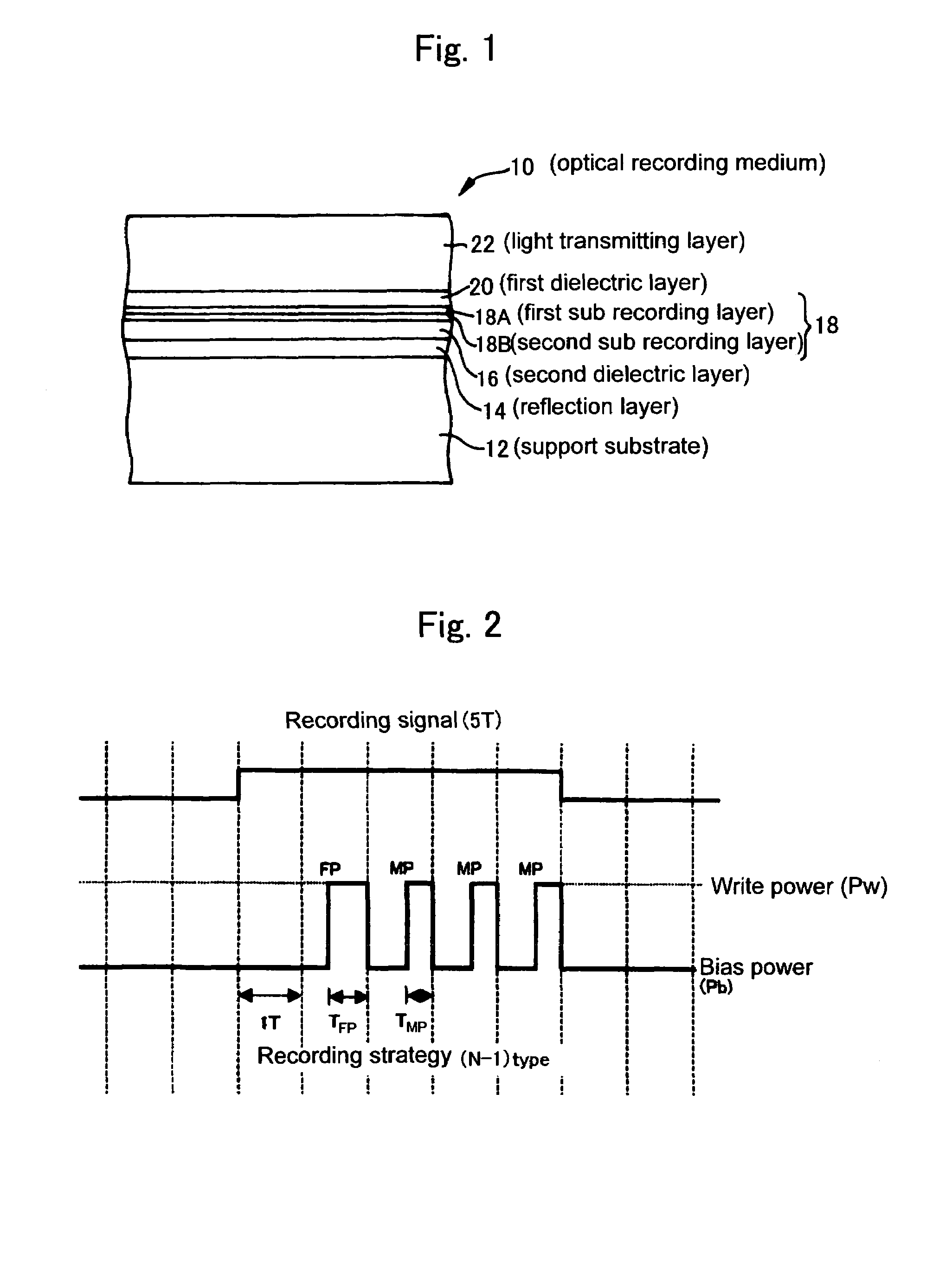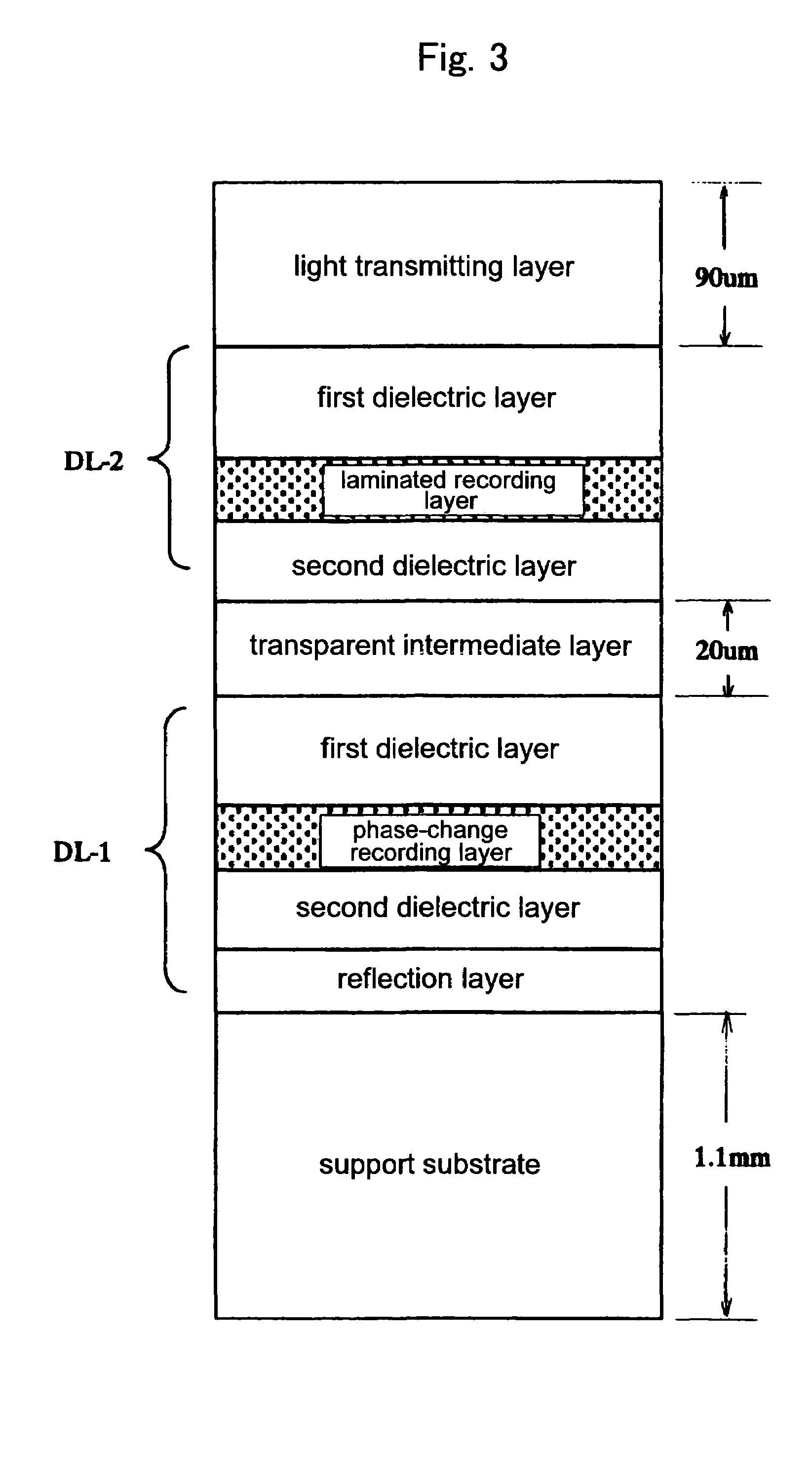Optical recording medium and recording method for optical recording medium
a recording medium and optical recording technology, applied in the field of optical recording medium and optical recording medium recording method, can solve the problems of insufficient recording structure, inability to synthesize dyes, insufficient storage reliability of recorded state, etc., and achieve high density and high-speed recording. , the effect of simple recording strategy
- Summary
- Abstract
- Description
- Claims
- Application Information
AI Technical Summary
Benefits of technology
Problems solved by technology
Method used
Image
Examples
example 1
[0080]Example Using Al and Sb as Main Component Metals.
[0081]An optical recording medium was produced in accordance with an arrangement shown in FIG. 1, an evaluation was conducted on a variable transfer rate.
[0082]The support substrate 12 was formed by a polycarbonate substrate of 1.1 mm having groups formed thereon at group pitch of 0.32 μm, while the thickness of the light transmitting cover layer 22 was set at 100 μm.
[0083]Other layers were produced by sputtering under the following condition.
[0084]Electrostatic layer: ZnS+SiO2 (80:20 mol %)
[0085]First dielectric layer 20: 60 nm
[0086]Second dielectric layer 16: 105 nm
[0087]First sub recording layer 18A: AlCr (98:2 at. %) 4 nm
[0088]Second sub recording layer 18B: Sb 6 nm
[0089]Reflection layer 14: AgPdCu (98:1:1 at. %) 100 nm
[0090]Random signals were recorded and playback was evaluated by an evaluation apparatus whose laser beam has a wavelength of 405 nm and whose objective lens group has a numerical aperture NA of 0.85, using mo...
example 2
[0100]Example Using Si and Cu as Main Component Metals.
[0101]An optical recording medium was produced in accordance with an arrangement shown in FIG. 1, an evaluation was conducted on a variable transfer rate in the same manner as in Example 1.
[0102]A support substrate and a light transmitting cover layer were formed in the same manner as in Example 1.
[0103]Other layers were produced by sputtering under the following condition.
[0104]Electrostatic layer: ZnS+SiO2 (80:20 mol %)
[0105]First dielectric layer 20: 22 nm
[0106]Second dielectric layer 16: 28 nm
[0107]First sub recording layer 18A: Si 5 nm
[0108]Second sub recording layer 18B: Cu 6 nm
[0109]Reflection layer 14: AgPdCu (98:1:1 at. %) 100 nm
[0110]The strategy used in the recording was such that the lengths of pulses in (n−1) type were set at TFP: 0.4T, TMP: 0.3T.
[0111]A read power (Pr) and a bias power (Pb) were all set at 0.4 mW.
[0112]Others are the same as those in Example 1, such that the recording transfer rate was changed, an ...
example 3
Example of Multilayer
[0133]An optical recording medium was made in accordance with an arrangement shown in FIG. 3, and an evaluation was conducted on the recording and playback of the multilayered recording medium.
[0134]This sample has two data layers separated from each other by a transparent intermediate layer. A laser beam is incident on the data layers from a light transmitting layer side so as to perform recording or playback on the two data layers.
[0135]The support substrate was formed by a polycarbonate substrate of 1.1 mm having groups formed thereon at group pitch of 0.32 μm.
[0136]The transparent intermediate layer, after being coated with an ultraviolet-setting resin by means of spin coating, is pressed by a stamper having a group pattern, and at the same time irradiated by an ultraviolet light so as to be cured and thus formed into a predetermined shape. Incidentally, this group pattern is the same as the group pattern on the support substrate, while the thickness of the ...
PUM
| Property | Measurement | Unit |
|---|---|---|
| wavelength | aaaaa | aaaaa |
| thickness | aaaaa | aaaaa |
| thickness | aaaaa | aaaaa |
Abstract
Description
Claims
Application Information
 Login to View More
Login to View More - R&D
- Intellectual Property
- Life Sciences
- Materials
- Tech Scout
- Unparalleled Data Quality
- Higher Quality Content
- 60% Fewer Hallucinations
Browse by: Latest US Patents, China's latest patents, Technical Efficacy Thesaurus, Application Domain, Technology Topic, Popular Technical Reports.
© 2025 PatSnap. All rights reserved.Legal|Privacy policy|Modern Slavery Act Transparency Statement|Sitemap|About US| Contact US: help@patsnap.com



